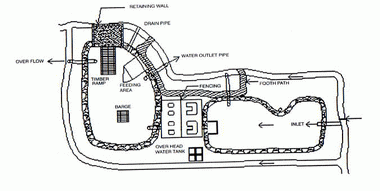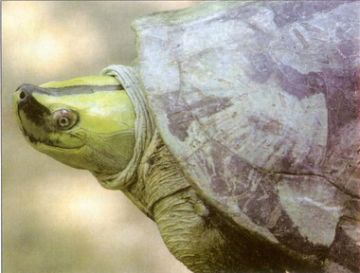DR. GERALD KUCHLING AND THE BURMESE RIDGE-BACK RIVER TURTLE.
From Newsletter 162
THE GIANT TORTOISES OF THE SEYCHELLES
The first project concerns the Giant Tortoises of the Seychelles (Dipsochelys). As regular readers of the newsletter will be aware Dr Justin Gerlach of the Nature Protection Trust of the Seychelles has been breeding them in captivity on Silhouette since 1997. He has claimed to have identified two distinct species of this tortoise - D.arnoldi and D.hololissa and the BCG has for some years been supporting his efforts.
CAPTIVE BREEDING SUCCESS
Not only was Dr Gerlach able successfully to track down specimens of the D. arnoldi and D.hololissa species (mainly in the Seychelles) but he also created suitable conditions on Silhouette Island favourable for breeding purposes. He had to spend a great deal of time and effort restoring to health some of the tortoises which were sick and under-nourished. After a slow start the animals settled down and eggs began to be laid. At first many were infertile and then Dr Gerlach's endeavours met with success and we received regular reports of hatchlings from him. The BCG shared in this project by adopting some of the tortoises, naming two D.hololissas Adam and Eve and then a hatchling, christened Oliphant after our former Chairman, the late Dr Oliphant Jackson.
THE NEED TO RELOCATE GIANT TORTOISES
Success in breeding the tortoises has now led to a problem. There are currently now 86 of them - comprising 9 D.hololissas (6 adults and three juveniles), 32 D.arnoldi (6 adults and 26 juveniles) and 45 cross-bred juveniles. Their quarters on Silhouette Island are now overcrowded and Dr Gerlach has to make plans to relocate them to other suitable places within the Seychelles group of' islands. He has managed to find locations which will provide a favourable habitat with plenty of room to accept the Glant Tortoisc progeny for many year's to come and where they too can breed. The tortoises will be in places where a regular eye can he kept oil them and veterinary assistance will be on hand if needed. They should be safe from both human and animal although no absolute guarantee can be given of not losing the odd one or two. Starting in 2005 the tortoises will be transported once or twice a year by boat or helicopter (two of the locations are at high level making them inaccessible for these large reptiles except by air). The relocation effort will continue for the next five years when the situation will be reviewed. Some of the places require the construction and erection of wooden tortoise-proof barriers. Within the location smaller release pens will be needed to accommodate groups of about 30 Giant Tortoises to prevent their dispersal at too early a stage after their release.
THE COSTS INVOLVED
Dr Gerlach is asking the BCG to fund the cost of transplanting the tortoises to the specified places over the first two years (2005-2007) as well as the costs of the construction and erection of the barriers and pens together with maintenance over that period. I have examined Dr Gerlach's figures and I am satisfied that he will need about £3,400 to complete the task of moving the majority of the current numbers of tortoises held on the Silhouette Captive Breeding Station and I commend the proposal to our members.
For more information see the Website The Giant Tortoises of the Seychelles
DR GERALD KUCHLING AND THE BURMESE RIDGE-BACK RIVER TURTLE
The second conservation project which I would like you to support by your donations in 2005 concerns an extremely rare Asian river turtle which rejoices under the name of the Kachuga trivittata or more simply the Burmese Ridge-back (or Roofed) Turtle. I have occasionally in the last two or three years told you about Dr Gerald Kuchling of the University of Western Australia, Perth, who is leading efforts to save this species of turtle from extinction. We have helped Gerald Kuchling before when the BCG funded his project to save the equally rare Western Australian Swamp Turtle (Pseudemydura umbrina). From a population of less than 50 in the world he was instrumental in a recovery programme which has increased the population now to over 300 - and they are thriving in the wild. Dr Kuchling's expertise and determination is renowned worldwide.
REDISCOVERY OF THE BURMESE RIDGE-BACK RIVER TURTLE
It was in 2002 that a turtle resembling the Kachuga trivittata was bought by a Chinese collector at a food market in China where it was just one of the many thousands of turtles imported from all over Asia to satisfy the trade to meet the demands of food, Chinese medicine and the collectors of rare turtles. Since at that time this species was thought to be extinct, the collector put a photo of the turtle on the internet, where it was recognised by Dr Kuchling. Now the problem was to discover just from where it had come from in Burma (by the way, the alternative name for this country is Myanmar). The last time the reptile had been seen was in 1935 in the upper reaches of the Chindwin River. Dr Kuchling went to Burma, aided by a grant from the BCG to try to find more of these rare creatures. He succeeded - but where he least expected to find them. On a recreational visit to a Burmese temple he recognised some of the Kachuga trivittatas in a pagoda pond along with turtles of many other species. In Buddhist philosophy individual merit is gained if you release captured turtles into these sacred ponds. Dr Kuchling was able, with the help of the monks, to retrieve 2 adult females and 1 adult male which were given to Mandalay Zoo for safe-keeping. They were kept in a disused elephant bathing pond but unfortunately during the monsoon rains the pool flooded and the male was washed away... This was an enormous setback but Gerald Kuchling is not the sort of man to give up easily. In a more recent expedition he has returned to rivers in N.Burma and has discovered more specimens of this rare river turtle. When I last heard from him he had a total of 6 - 2 adult and 1 sub-adult females, 1 adult and 1 juvenile male together with a juvenile of undetermined sex. These are now safe in Mandalay Zoo and it is the beginning of a "colony of assurance" from which it is hoped to breed more of them, perhaps starting in 2005.
THE BCG INVOLVEMENT
Dr Kuchling wants to create in the Zoo (and he has their complete cooperation) a series of ponds for the Kachuga trivittatas. Some will be holding ponds for more turtles which he believes can be captured in further expeditions (the local fishermen assure him that they can find them in remote stretches of the rivers); other ponds will provide the conditions for captive breeding and for rescued hatchling turtles until they reach sufficient maturity to be taken back to the river and released in a headstarting programme. The cost of creating these facilities will be expensive but the BCG has set as its aim to provide about £3000. Dr Kuchling is also supported by the Wildlife Conservation Society as well as by private donors who are helping with the cost of the expeditions and the payment of specialists to support the project. There is much more that I want to tell you about this exciting project of Dr Kuchling's - but I am going to reserve that for another edition of the Newsletter.
CONCLUSION
I am putting before the BCG membership two fascinating and imaginative proposals which I believe demand our very best support. One is helping to restore to the Seychelles Islands the Giant Tortoise which once used to roam there centuries ago. The other concerns a rare species of river turtle, which Dr Kuchling is hoping to bring back from the brink of extinction. Both Dr Gerlach and Dr Kuchling are experts in their fields and I and the rest of your committee have no hesitation in pledging the support of the BCG to both projects. This will mean that we ask you to be particularly generous in 2005 and from your past record of giving over many years I feel certain we can attain our goal of £6500 next year. You can make a donation when you renew your membership by adding the amount you wish to donate to the form or you send a separate donation by cheque to the Membership Secretary BCG, PO Box 1460, Bedworth, CV1 29ZR. Please make the cheque out to the British Chelonia Group and specify that you wish the money to go to the 2005 Conservation Appeal. And thank you for your help.
BOB LANGTON, CONSERVATION OFFICER
email: Conservation Officer
CONSERVATION CORNER: THE BURMESE RIDGE-BACK TURTLE
Members will recall that as one of the objects of our 2005 Conservation Appeal, we asked for your support to save one of the most critically endangered river turtles in the world - the Burmese Ridge-back Turtle or Kachuga trivittata. There are only six in captivity and they are being treasured at Mandalay Zoo by Dr Tint Lwin and his staff in the Herpetological Section there. The BCG has been working with the Turtle Survival Alliance (TSA) to find money to create the best possible conditions in the Zoo to encourage captive breeding among these rare reptiles and I am pleased to report that we have raised the target figure of £3000 through the generous support of our members.
During the latter half of 2005 the TSA, with the help of a local architect, has been engaged with planning the new captive breeding and holding facility and they have come up with a plan that is possibly the finest and largest that has ever been designed for just six turtles, utilizing the two existing water retention ponds in which the turtles are already housed. The features include an anchored basking platform, a nesting beach with a floating ramp, a caged feeding area for containment when needed, and improved water flow throughout. The latter includes pushing water from adjacent canals through a water hyacinth choked pond for pre-filtration, pumping clean water from this pond to a water tower that then gravity feeds the series of grow-out and isolation ponds between the two large ponds. The total cost for this work is estimated to be about £6500 - so the BCG is funding nearly half the total cost of this impressive undertaking. Members will be pleased to know that Dr Gerald Kuchling, who spent so much time and effort in tracking down these elusive turtles with BCG support, is very happy with the design of this captive-breeding facility even though he is not directly concerned with the project any longer. Construction was due to begin in January 2006.
My thanks go to Rick Hudson of Fort Worth Zoo, Texas and co-founder of the TSA (Turtle Survival Alliance) for this information. Both he and Bill Holmstrom of the Bronx Zoo, New York, will be overseeing the building during visits to the Mandalay Zoo to make sure it is perfectly satisfactory for the privileged river turtles. Soon there will be a much improved chance that the Burmese Ridge-back River Turtle can be saved from extinction.
BOB LANGTON, CONSERVATION OFFICER
email: Conservation Officer
Top



